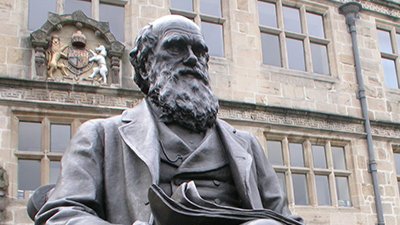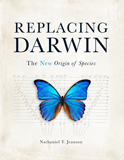
The Ultimate Scientific Rebuttal to Darwin’s Descent of Man?
Breakthrough findings repudiate Darwin with falsifiable and fulfilled predictions—the gold standard of actual scientific research.
This year (AD 2021) marks the 150th anniversary of Charles Darwin’s second major origins work, The Descent of Man. Published twelve years after his more famous 1859 publication, On the Origin of Species, Darwin’s book Descent of Man picked up where On the Origin had left off. In 1859, Darwin had sidestepped the delicate question of human evolution:
In the distant future I see open fields for far more important researches . . . Light will be thrown on the origin of man and his history.1
In Descent of Man, Darwin took up the human origins question and ran with it.
Your Parents: The Animals
Darwin’s Descent of Man is unambiguous in its conclusions: Man evolved from lower animals; man is not a special, direct creation of God. Nevertheless, when reflecting on the implications of his thesis, Darwin waxed philosophical:
Darwin’s Descent of Man is unambiguous in its conclusions: Man evolved from lower animals; man is not a special, direct creation of God.
Thus we have given to man a pedigree of prodigious length, but not, it may be said, of noble quality. The world, it has often been remarked, appears as if it had long been preparing for the advent of man; and this, in one sense is strictly true, for he owes his birth to a long line of progenitors. If any single link in this chain had never existed, man would not have been exactly what he now is. Unless we wilfully close our eyes, we may, with our present knowledge, approximately recognise our parentage; nor need we feel ashamed of it. The most humble organism is something much higher than the inorganic dust under our feet; and no one with an unbiassed mind can study any living creature, however humble, without being struck with enthusiasm at its marvellous structure and properties.2
On the question of human evolution, the modern scientific community has followed in Darwin’s footsteps. Surveys show that over 90% of scientific professionals accept that “Humans and other living things have evolved over time due to natural processes such as natural selection.”3
This statistic becomes even more significant when you consider the other answers that the survey participants could have chosen. The participants could have chosen an answer that sounds like theistic evolution, and they could have picked one that sounded closer to creationism. Only 10% did.4
What’s the chance that the mainstream scientific community will give up their view of human evolution? What reason do we have to anticipate that the acceptance of Darwin’s views will ever change?
Surprisingly, one reason comes from Darwin himself.
Reversing the Consensus
When Darwin wrote On the Origin of Species, he knew he was facing an uphill battle. Near the close of his book, he asked a rhetorical question:
Why, it may be asked, have all the most eminent living naturalists and geologists rejected this view [i.e., Darwin’s view]?5 [emphasis added]
In 1859, Darwin didn’t take the opposition lying down. He sought to persuade “all the most eminent living naturalists and geologists” who opposed him to change their view.
In 1859, Darwin didn’t take the opposition lying down. He sought to persuade “all the most eminent living naturalists and geologists” who opposed him to change their view. He did so by appealing to them in several ways. Two are especially relevant today. First, Darwin reviewed the facts that he cited in support of his case. Second, he explicitly appealed to the younger generation, claiming the older naturalists were too entrenched in their views:
Although I am fully convinced of the truth of the views given in this volume under the form of an abstract, I by no means expect to convince experienced naturalists whose minds are stocked with a multitude of facts all viewed, during a long course of years, from a point of view directly opposite to mine . . . But I look with confidence to the future, to young and rising naturalists, who will be able to view both sides of the question with impartiality. Whoever is led to believe that species are mutable will do good service by conscientiously expressing his conviction; for only thus can the load of prejudice by which this subject is overwhelmed be removed.6
Apparently, Darwin’s appeals were successful. In the 1869 edition of On the Origin of Species, Darwin’s sentence read differently:
Why, it may be asked, until recently did nearly all the most eminent living naturalists and geologists reject this view of the mutability of species.7 [emphasis added]
Will history repeat itself in 2021? What will it take to overturn the conclusions set forth in Descent of Man?
Following Darwin’s precedent, a first step in this direction might be a review of all the facts in support of a contrary case. In a sense, this has already been done. In 2017, I published a book, Replacing Darwin: The New Origin of Species, that comprehensively examined the shortcomings of evolution and offered a better explanation. Replacing Darwin tackled everything from anatomical similarities between humans and animals, to human-chimp genetic similarity, to genetic clocks that mark off 6,000 years of history.
A second step might be asking whether Darwin’s observations of human nature still ring true. Is it worthwhile to still appeal to the younger generation to make the case? Unequivocally, yes.
Legal and Scientific Constraints
In 2021, a third step must follow these two. Unlike Darwin’s day, the modern creation/evolution debate exists in a scientific climate that, at least in the US, has been enshrined in federal court decisions.
Unlike Darwin’s day, the modern creation/evolution debate exists in a scientific climate that, at least in the US, has been enshrined in federal court decisions.
One of the most significant decisions was handed down in 1982.8 In question was an Arkansas law mandating the teaching of creation science alongside evolution. Judge Overton overturned the law, and he did so on the basis of what constitutes and does not constitute genuine science.9
In Overton’s view, science must meet several criteria, one of which is the criterion of falsifiability. To be falsifiable, a scientific hypothesis must make claims that future experiments could reveal to be true or false. Overton claimed that creation science makes no such claims.
Overton’s logic pervades the mainstream scientific community to this day. You can find the insistence on falsifiability reiterated in popular college textbooks on evolution10 and layman-friendly defenses of evolution.11
In other words, for creation science to overturn Descent of Man, creationists will need to propose falsifiable predictions related to the origin of mankind.
Meeting the “Gold Standard”
When I wrote the book Replacing Darwin in 2017, this was the standard I sought to meet. Replacing Darwin contains numerous testable predictions. One in particular applied directly to the question of human origins:
The YEC [young-earth creation] anthropology that I just outlined makes another prediction. Since my model traces the origin of nearly all the “common” [DNA] variants back to Adam and Eve, my model suggests that the history of civilization can be read off of the nuclear DNA differences [i.e., one category of DNA differences] among the peoples of the globe—and on a timescale consistent with the YEC model.
For example, in the last few hundred years, European colonization and the Trans-Atlantic slave trade have resulted in major geographic movements of peoples around the globe. These movements will leave a signature in the genetics of each of these peoples.12 [emphasis added]
I also articulated these claims with respect to a specific type of “nuclear” DNA that is inherited only in males, the Y chromosome:
Thus, both the mtDNA [mitochondrial DNA, a type of DNA inherited through the female line] and Y chromosome sequences have the potential to act as strict, absolute molecular clocks. The rate of mutation in each of these compartments will determine how precisely each can measure time. But the fact of a clock is true in both compartments. Therefore, the timing of the origin and migration of various people groups can be interrogated with these genetic tools.
The Y chromosome differences among modern humans represent, in theory, the first type of nuclear DNA signature of the history of civilization.13
Since then, I’ve published three papers14 that directly confirmed these predictions for the Y chromosome.
With this precedent in hand, in spring and summer of 2020 I began to explore the global ramifications of these findings. I looked for the signatures of human history in the DNA of people all around the globe. You can find the results of this early search in a video series I did with Ken Ham on YouTube.15
With this precedent in hand, in spring and summer of 2020 I began to explore the global ramifications of these findings. I looked for the signatures of human history in the DNA of people all around the globe.
Since airing the initial results in a video series, I’ve been working intensely on the remaining signatures of human history in our DNA. The results have been stunning. For example, we now know that most people of European descent came from Central Asia in the AD era. Also, much of sub-Saharan Africa looks like it’s linked to ancient Egypt. Modern Polynesians might also have their origins in ancient Africa.
The Hidden History of Humankind
These and other findings will be released this summer/fall in a book (the current title is The Hidden History of Humankind: Unexpected links among ancient civilizations—though the title may change before it goes to press). In the book, I will be exploring the rise and fall of eight ancient civilizations or peoples: Ancient Egypt, ancient Rome, ancient Persia, ancient Israel, ancient India, ancient China, the Easter Islanders, and the Native Americans. With modern genetics, I will then try to answer the questions that most history books never address: Who did these people come from, and what happened to them after their civilizations fell?
In answering these questions for these eight peoples, I end up telling the story of the whole world.
Effectively, this book fulfills the testable predictions I made several years ago. In doing so, it meets the decades-old demands of the evolutionary community. The book does science; it advances our knowledge of the natural world. Rather than simply identify the shortcomings of evolution, it confirms testable predictions that I made in the past, and it makes more falsifiable predictions for the future.
In 2021, this is precisely the type of rebuttal to Descent of Man that the scientific community requires. Will they recognize that we’ve met—and exceeded—their demands?
Footnotes
- Charles Darwin, On the Origin of Species by Means of Natural Selection (London: John Murray, 1859), 488, http://darwin-online.org.uk/content/frameset?pageseq=506&itemID=F373&viewtype=side.
- Charles Darwin, The Descent of Man (London: John Murray, 1871), 213, http://darwin-online.org.uk/content/frameset?pageseq=226&itemID=F937.1&viewtype=side.
- Pew Research Center, “Elaborating on the Views of AAAS Scientists, Issue by Issue,” https://www.pewresearch.org/science/2015/07/23/elaborating-on-the-views-of-aaas-scientists-issue-by-issue/#views-about-evolution, accessed January 27, 2021.
- Pew Research Center, “Elaborating.”
- Darwin, Origin, 480, http://darwin-online.org.uk/content/frameset?pageseq=498&itemID=F373&viewtype=side.
- Darwin, Origin, 481–482, http://darwin-online.org.uk/content/frameset?itemID=F373&viewtype=text&pageseq=1.
- Darwin, Origin, 569, http://darwin-online.org.uk/content/frameset?pageseq=601&itemID=F387&viewtype=side.
- McLean v. Arkansas Board of Education, https://law.justia.com/cases/federal/district-courts/FSupp/529/1255/2354824/.
- McLean v. Arkansas Board of Education.
- Douglas Futuyma and Mark Kirkpatrick, Evolution (Sunderland, MA: Sinauer Associates, Inc., 2017).
- Niles Eldredge, The Monkey Business: A Scientist Looks at Creationism (New York: Washington Square Press, 1982).
- Nathaniel T. Jeanson, Replacing Darwin: The New Origin of Species (Green Forest, AR: Master Books, 2017), 229–230.
- Nathaniel T. Jeanson, Replacing Darwin: The New Origin of Species (Green Forest, AR: Master Books, 2017), 230.
- Nathaniel T. Jeanson, “Testing the Predictions of the Young-Earth Y Chromosome Molecular Clock: Population Growth Curves Confirm the Recent Origin of Human Y Chromosome Differences,” Answers Research Journal 12 (2019): 405–423.
Nathaniel T. Jeanson and Ashley D. Holland, “Evidence for a Human Y Chromosome Molecular Clock: Pedigree-Based Mutation Rates Suggest a 4,500-Year History for Human Paternal Inheritance,” Answers Research Journal 12 (2019): 393–404.
Nathaniel T. Jeanson, “Young-Earth Y Chromosome Clocks Confirm Known Post-Columbian Amerindian Population History and Suggest Pre-Columbian Population Replacement in the Americas,” Answers Research Journal 13 (2020): 23–33. - See https://www.youtube.com/playlist?list=PL1v9pqs4w1mwrGlCET76Rs99Fx0EfJXE4. A higher quality version can be found on our streaming channel, Answers.tv.
Recommended Resources

Answers in Genesis is an apologetics ministry, dedicated to helping Christians defend their faith and proclaim the good news of Jesus Christ.
- Customer Service 800.778.3390
- © 2024 Answers in Genesis






